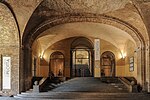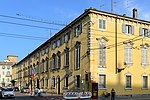Galleria nazionale di Parma
1760 establishments in ItalyArt museums and galleries in Emilia-RomagnaArt museums established in 1760Galleria nazionale di ParmaMuseums in Parma ... and 1 more
National galleries

The Galleria nazionale di Parma is an art gallery in Parma, northern Italy. Painters exhibited include Beato Angelico, Canaletto, Correggio, Sebastiano del Piombo, Guercino, Leonardo da Vinci, Parmigianino (Mystic Marriage of Saint Catherine), Ludovico Carracci (The Funeral of the Virgin Mary), Agostino Carracci (Madonna and Child with Saints), Tintoretto and others.
Excerpt from the Wikipedia article Galleria nazionale di Parma (License: CC BY-SA 3.0, Authors, Images).Galleria nazionale di Parma
Piazza della Pilotta, Parma Parma Centro
Geographical coordinates (GPS) Address Nearby Places Show on map
Geographical coordinates (GPS)
| Latitude | Longitude |
|---|---|
| N 44.804722222222 ° | E 10.325861111111 ° |
Address
Teatro Farnese
Piazza della Pilotta
43121 Parma, Parma Centro
Emilia-Romagna, Italy
Open on Google Maps











